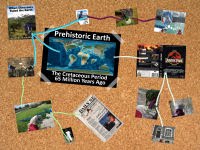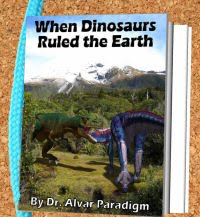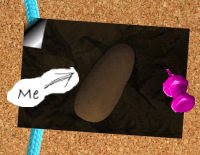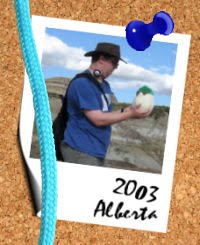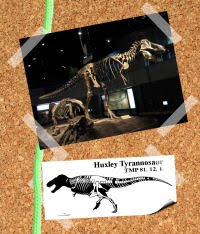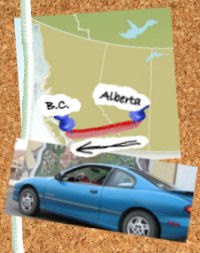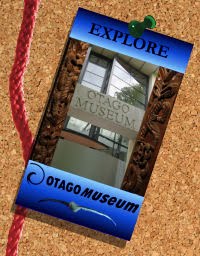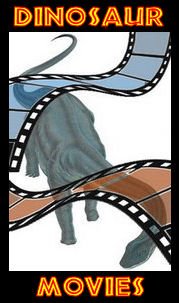(i will say in advance, sorry if this post is a little chaotic. bloggers formatting has been giving me no end of grief with this post... delaying it by several days, and i've decided to give up. so just imagine it to be nice and well laid out like i'd planned... pleaseeeeee) since i've been looking into the history of alberta's fossil hunting, and about to look for some fossils while i'm at it, i thought maybe it'd be handy to know some of the dinosaurs that have been found around the province. in case i run into some (hopefully!)... and so you're on the same page as me.  alberta has a great fossil record of the last 14-16 million years of the cretaceous, meaning any dinosaurs or other organisms we find are among THE last to exist during the mesozoic. alberta has a great fossil record of the last 14-16 million years of the cretaceous, meaning any dinosaurs or other organisms we find are among THE last to exist during the mesozoic._ despite coming from the same general time period and geographic area, these dinosaurs didn't all co-exist at the same time. that's because 15 million years is still a HUGE span of time, and a lot of things changed during it. _  as you'll recall from my last post on the geology of alberta, that big chunk of 15 million years can be broken down into small blocks that we call formations. these aren't just made up to break up the time any which way. the formations mark traceable and important changes that happened here in alberta throughout the end of the cretaceous. some mark changes in climates, environments, and living things. others mark the dramatic change of land being flooded by an ocean, and others the draining of that ocean leading to once more land. as you'll recall from my last post on the geology of alberta, that big chunk of 15 million years can be broken down into small blocks that we call formations. these aren't just made up to break up the time any which way. the formations mark traceable and important changes that happened here in alberta throughout the end of the cretaceous. some mark changes in climates, environments, and living things. others mark the dramatic change of land being flooded by an ocean, and others the draining of that ocean leading to once more land._ seriously if you want to learn more about how and why we figure out these formation read the alberta geology post first (same link as the one in the last paragraph... just giving you a second chance to click it is all). _ so let's take a look at these dinosaurs formation by formation. this immediately will help you get an idea of not only which albertan dinosaurs coexisted, but start to see the evolutionary changes that were happening here at the end of the age of dinosaurs. i'm only going to cover layers with dinosaurs, and skip the marine ones... for now. _ 1. Milk River (84 million years ago [mya]- ?mya this is the earliest (as in furthest back in time from the present) record of the cretaceous in alberta. it begins around 84 million years ago, but we don't know for sure exactly when it extends to datewise (layerwise we now where the milk river ends as it is replaced by marine deposits of the Pakowki). it is exposed around the milk river of the southmost part of alberta, hence the name. _ there are dinosaur fossils (as well as other animals) present in this formation, however they have not been extensively collected or studied... until recently. a great deal of emphasis has been placed on increasing our understanding of this early part of the cretaceous by palaeontologists the last 5 years or so. _ as most of these finds have not yet been completely published or even preped yet, most of these dinosaurs haven't been positively identified. _ we know there are hadrosaurs, certatopsians, ankylosaurs, dromaeosaurs, troodontids, ornithomimids, and tyrannosaurids of various types. however as of yet, we don't know exactly what kinds. whether they are new or types already known...  2. Oldman Formation (77-76 mya) the base layers of alberta's most dinosaur rich area, dinosaur provincial park, are made of the oldman formation. the oldest formation that reliable specimens and studies have so far been produced from. at the same time despite DPP's abundance of dinosaurs and other fossils, they do not come from its base layers. the oldman seems to have been an environment with less elements needed for fossilization. _ yet at the same time because the area has been worked so heavily in the last hundred or so years enough discoveries have been made in the oldman that we have a descent fossil record for it. Hadrosaurs
_ it was fairly typically of the crest-less hadrosaur, except for its the rather large and "swollen" looking nose.
Ceratopsians centrosaurus brinkmani- one of the most recently discovered of alberta's dinosaurs was this new unique species of centrosaurus. it differs from later centrosaurs due to the unique ornamentation on its frill. centrosaurus b. was naturally a member of the centrosaurinae, or the short frilled ceratopsians.  albertaceratops- found in 2001, this another one of the most recently discovered dinosaurs in alberta. _ albertaceratops was another short frilled ceratopsian (a centrosaurinae), it was a unique amongst this group as the only one to have longer eye horns than that on its nose (it didn't have a nose horn at all... just a little ridge of bone sticking out).  chasmosaurus- there was a long frilled ceratopsian (a ceratopsinae) present in the oldman. chasmosaurus would go on into dinosaur park formation. chasmosaurus- there was a long frilled ceratopsian (a ceratopsinae) present in the oldman. chasmosaurus would go on into dinosaur park formation.Ankylosaurs  euoplocephalus- this one of the longest surviving ankylosaurs was present in the oldman, but went on until the horseshoe canyon. euoplocephalus- this one of the longest surviving ankylosaurs was present in the oldman, but went on until the horseshoe canyon._ Theropods  dromiceiomimus- first discovered in 1926, but not recognized as a new type of ornithomimid (it was first thought to be a struthiomimus) until 1972. dromiceiomimus was unique among the ostrich mimics due to its especially large eye size, and long legs. this leg size is evidence this would have been the fastest of dinosaurs, but with no footprints to prove this is just a hunch. dromiceiomimus- first discovered in 1926, but not recognized as a new type of ornithomimid (it was first thought to be a struthiomimus) until 1972. dromiceiomimus was unique among the ostrich mimics due to its especially large eye size, and long legs. this leg size is evidence this would have been the fastest of dinosaurs, but with no footprints to prove this is just a hunch. daspletosaurus- this was possibly the direct ancestor of us tyrannosaurus rexes, and they were the top predator of the oldman. apart from being about a 1/3 smaller than us t-rexes, daspletosaurs were otherwise as heavily built and proportioned as us. they would survive into the dinosaur park era. daspletosaurus- this was possibly the direct ancestor of us tyrannosaurus rexes, and they were the top predator of the oldman. apart from being about a 1/3 smaller than us t-rexes, daspletosaurs were otherwise as heavily built and proportioned as us. they would survive into the dinosaur park era.charlie sternberg first found daspletosaurus in 1921, but thought it was just a species of gorgosaurus. it wasn't until 1970 that dale russell decided it was different. _ 3. Dinosaur Park Formation (76-74 mya) this is among the most dinosaur rich deposits in the world, and has produced many of the best known of dinosaurs. for the animals that survive into this formation from the oldman, i've done their proper blurb here as most were first found in this formation (i don't remember if any were first found in the oldman). Hadrosaurs  brachylophosaurus- a crestless hadrosaur, discovered in 1936, but not worked on till 1956 by charlie sternberg. brachylophosaurus- a crestless hadrosaur, discovered in 1936, but not worked on till 1956 by charlie sternberg.it had a paddle like plate over the front end of its skull, and a very wide beak for a dinosaur park duckbill. gryposaurus-this duckbill has been found in the dinosaur park formation, but was much more common in the oldman. prosaurolophus- found by barnum brown in 1915, was a fairly non-descript crestless duckbill. apart from a ridge above and in-between the eyes.  lambeosaurus-one of the first crested duckbills to have ever been found in the world. first found by lawerence lambe in 1898, but not formerly named till after his death. part of why lambeosaurus was named in honour of canada's first domestic palaeontolgist (a sad reason), but also done so in recognition of his many achievements. two species of lambeosaur are found in dinosaur park. in older books you'll see these as being thought to be male and female of each other. however due to darren tanke's lost quarry project, we now know that these "boys" and "girls" lived at different times, with the girls all coming from the bottom layers of the formation, and the boys coming from the top ones. meaning either they had some clever time travel dating techniques or they were different species. lambeosaurs had very cool crests. one the front end was a squared off circle and behind that a prong sticking out backwards.  corythosaurus- this crested duckbill is among the most common large dinosaur in the dinosaur park formation. it is a fairly typical duckbill other than it looks like it has had a dinner plate stuck on the top of its head. _ the first corythosaur was found by barnum brown in 1912.  parasaurolophus- this crested hadrosaur is probably the most famous duckbill of them all, but yet one of alberta's rarest. only a couple have ever been found. this has lead to the idea (plus details of the anatomy) to the idea this was a more inland duckbill, that didn't actually live on the flood plains that were dinosaur park in the cretaceous. parasaurolophus- this crested hadrosaur is probably the most famous duckbill of them all, but yet one of alberta's rarest. only a couple have ever been found. this has lead to the idea (plus details of the anatomy) to the idea this was a more inland duckbill, that didn't actually live on the flood plains that were dinosaur park in the cretaceous.levi sternberg found the first one ever here in alberta in 1920. however the next year 1921, his father charles found more in new mexico, an area these dinosaurs are commonly found in (though a different species to the alberta ones). Ceratopsians  styracosaurus- among the most spectacular of the short frilled ceratopsians. this multi horned (all but the nose horn were on the shield like frill on the rear of the skull). it was first found by charles sternberg in 1913, but barnum brown in 1915 found a rather spectacular specimen in the park as well.  centrosaurus- the nose horned, short frilled ceratopsian. lawerence lambe first discovered them in 1904, but they are among the most common fossil remains in the bonebed layers of dinosaur park. these massive bonebeds are currently thought to be the remains of herds of these ceratopsians caught in tropical storms that would cause the ocean to flood the very flat floodplain that was dinosaur park, and bury whole herds of these guys!  chasmosaurus-this long frilled ceratopsian was another of lambe's finds, back in 1901. it is notable due to its rather short horns, but mega huge frill (which was so big it needed to two big holes to keep its weight down).  pachyrhinosaur-like ceratopsian- the newest alberta dinosaur is one that looks very similar to pachyrhinosaurus, but the specimen was missing its frill. a key feature for IDing it one way or the other as any of the currently known pachyrhino. pachyrhinosaur-like ceratopsian- the newest alberta dinosaur is one that looks very similar to pachyrhinosaurus, but the specimen was missing its frill. a key feature for IDing it one way or the other as any of the currently known pachyrhino.Pachycephalosaurs  stegoceras- the discovery of the complete skeleton of this boneheaded dinosaur by george sternberg in 1923 helped solve one of the biggest dinosaur mysteries of that era. in 1901 lambe had found and named the first bony skull cap, but no one could figure out what sort of animal it had come from. for years this was the only complete pachycephalosaur known, and is still the most intact skeleton for this group.  colepiocephale- a newly renamed genus of bonehead (its latin name MEANS knucklehead! how great is that?!?) in 2003. it was first found by levi sternberg in 1945, but he thought it was another stegoceras. there are several more bonehead dinosaurs theoretically from alberta, but due to their incomplete nature palaeontologists are constantly arguing what they are. as of such i'm out of the loop (and as these guys are among my least fav dinos... i don't keep a close eye on them). _ Ankylosaurs  edmontonia- this clubless armoured dinosaur (a nodosaurid) is found in the dinosaur park formation, but its would live on into the later horseshoe canyon. the first one was found here in 1915, but was not recognized as being edmontonia until 1928. panoplosaurus-was similar to edmontonia, in that it was covered in armour (like all ankylosaurs) and had spikes along the neck and sides with particularly massive ones above the shoulders. panoplosaur had a different skull structure to edmontonia however which was used to separate the two.  euoplocephalus-this is the classic clubbed ankylosaur (partially because so many of them have been found throughout most of the formations of alberta!). _ lambe found the first incomplete remains in 1902, but nearly every museum that received skeletons from the great canadian dinosaur rush ended up with a euoplocephalus (not because they were common in any one formation, but again because they were findable nearly everywhere dinosaur bearing in the province). Theropods  chirostenotes- has taken nearly half a century to take form. bits and pieces of this oviraptor had been found throughout the 1920s, 30s, and 40s, but it was not realized they all went together until a complete skeleton was preped in 1988 (though it had been found in 1923). the discovery of chirostenotes was a pretty big deal. not only was it among the first north american oviraptors found (the first if you count when it was found, rather than recognized), but it was further proof for the land bridge connecting north america and asia in the late cretaceous.  unnamed therzinosaurid- there have been bits and pieces (especially the trademark finger claws) of a plant eating therzinosaur found at DPP. however not enough of this animal has been found to make a clear ID. needless to say this was yet another asian dinosaur that in the geologic record suddenly just showed up in north america. if not a land bridge, than how? unnamed therzinosaurid- there have been bits and pieces (especially the trademark finger claws) of a plant eating therzinosaur found at DPP. however not enough of this animal has been found to make a clear ID. needless to say this was yet another asian dinosaur that in the geologic record suddenly just showed up in north america. if not a land bridge, than how? struthiomimus- was the first ever ornithomimid from which a relatively complete skeleton was found. back in 1914, henry osborn wishing for some small dinosaurs for his growing collection of alberta dinosaurs in new york, asked barnum brown to try and find some small theropods. as if in answer to this request (which doesn't usually happen when you go fossil hunting!) brown discovered a complete skeleton! _ since then many more specimens of this dinosaur have been found. it may have been among the most common of small dinosaurs in dinosaur park in the cretaceous (but it is hard to say as small animals don't fossilize well there) as it is the most common for whom fossils are found today. it is also known from the horseshoe canyon formation. _ ornithomimus and dromiceiomimus- both these ostrich mimics were also present in the dinosaur park formation, but their blurbs are elsewhere.  troodon-the intelligent raptor relative (but not a true member of) was present in dinosaur park, but its most famous remains are from the horseshoe. so its proper blurb shall wait until than. troodon-the intelligent raptor relative (but not a true member of) was present in dinosaur park, but its most famous remains are from the horseshoe. so its proper blurb shall wait until than. saurornitholestes- the most common dromaeosaurid in the dinosaur park era by far. its teeth are extremely common at micro fossil sites, and though skeletal remains weren't found till more recent, 1974, it now has more material than any other small predatory theropods (where as the more common ornithomimids didn't eat meat remember). this guy differed from most other north american raptors by being more lightly built, and having a slender skull... very similar to the asian velociraptor hmmm another case of a land bridge... maybe!  dromaeosaurus- the first raptor known from good skeletal material found by barnum brown in 1914 in alberta. this however has remained the ONLY skeletal material known. contrary to various TV shows and documentaries, dromaeosaurs never lived with tyrannosaurus or edmontosaurus. it has only been confidently found in the dinosaur park formation (and POSSIBLY, based on some teeth, in a similar timed layer in montana... perhaps!). in fact based on its rarity, despite being the longest known raptor, dromaeosaurus is one of the least understood of this group of dinosaurs. dromaeosaurus- the first raptor known from good skeletal material found by barnum brown in 1914 in alberta. this however has remained the ONLY skeletal material known. contrary to various TV shows and documentaries, dromaeosaurs never lived with tyrannosaurus or edmontosaurus. it has only been confidently found in the dinosaur park formation (and POSSIBLY, based on some teeth, in a similar timed layer in montana... perhaps!). in fact based on its rarity, despite being the longest known raptor, dromaeosaurus is one of the least understood of this group of dinosaurs. gorgosaurus- this tyrannosaurid was easily the most common large theropod of dinosaur park, and this geologic unit has produced more complete skeletons of this tyrannosaurid than any two other tyrannosaur species combined (other than tarbosaur, who is possibly starting to match gorgosaurus on complete skeletons). gorgosaur was found by charlie sternbergs in 1913. barnum brown and the sternbergs would find many more during the dinosaur rush, and still more have been found since. however based on the argument over whether gorgosaurus is actually an early albertosaurus you might have to sub the first discovery with that of albertosaurs mentioned below. here's my take on the gorgosaurus vs. albertosaurus issue. daspletosaurus- again this heavier built (but otherwise same sized as gorgosaurus) tyrannoaurid was present in the dinosaur park formation as well. this led to the only instance where two large tyrannosaurid species lived in the same environment. it has been speculated that they ate different prey. the heavier daspletosaur possibly favouring the horned ceratopsians, and the lighter gorgosaurus going for hadrosaurs. there isn't really any evidence to support this though (the fact a montanan daspletosaur has been found with an edmontosaur in its gut. which doesn't really seem to make this idea of different prey work if you ask me). gorgosaurus was clearly more common, and so daspletosaurs may have been upland predators who just occasionally wandered down to the flood plain (maybe following upland herbivores like parasaurolophus and stegoceras?). next we travel to drumheller, and the layers i'll be looking at a lot in the next while.
Hadrosaurs  saurolophus- was the first complete dinosaur skeleton found in canada, by barnum brown in 1911. this first skeleton and the remains of a few other animals buried with it are the only record of this dinosaur in canada. yet an almost identical animal from a similar timeframe existed in cretaceous china. (*cough* land bridge*cough**cough*) despite it being technically a crestless (hadrosaurid, as opposed to the crested lambeosaurids) this duckbill had a shaft of bone sticking off the rear of the skull. though this appears to be a crest (which in a way i guess it is), scientifically the crests of the crested duckbills were elaborate hollow structures. saurolophus' spike was just a solid spike of bone... edmontosaurus- the classic duckbilled duckbill. it has a VERY complicated history with earlier discoveries in america during the bonewars (getting more than 10 names during that time). however a complete skeleton found by levi sternberg in 1912 just downriver from drumheller would go on to become the type specimen for this dinosaur. since than, MANY more edmontosaurs have been found. in fact, with no competition, this is the single most common dinosaur to find in the horseshoe canyon formation, and possibly alberta (just due to the number of them you find around drumheller... dinosaur park has so much more variety than the horseshoe, so it doesn't produce any single animal in such numbers!). edmontosaurs was the classic crestless duckbill build, with a massive broad duck like beak on the end of its snout.
Hypsilophodons  parksosaurus- a later surviving hypsilophodont first found by william parks in 1926, but he felt it was a species of thescelosaurus. charlie sternberg reassessed this in 1940, found it was a different animal, and so renamed it in honour of its (sadly passed on by this time) discoverer. Ceratopsians  pachyrhinosaurus- this bony nosed ceratopsian was the last of the short frills to exist. pachyrhinosaurus- this bony nosed ceratopsian was the last of the short frills to exist.it was also the most common ceratopsian to exist during this time in the northern areas of the province. a massive bonebed in pipestone creek has preserved the remains of dozens and dozens of these animals, including skulls of nearly every growth stage of this animal. which has shed huge light on how short frill ceratopsians all looked growing up. which was identical! they seriously all looked the same until just before adulthood when they would start to grow and develop their unique frill and head ornamentation (such as horns and bone bumps). the first pachyrhino was found by charlie sternberg in 1946 near drumheller. however the rich northern deposits weren't found near grande prairie till 1972, by local teacher al lakusta.  arrhinoceratops- this long frilled ceratopsian is known from only a single skull found in 1923. it is unusual for having a very puny nose horn, that was so small it was thought to not exist when the specimen was named in 1926. arrhinoceratops- this long frilled ceratopsian is known from only a single skull found in 1923. it is unusual for having a very puny nose horn, that was so small it was thought to not exist when the specimen was named in 1926. anchiceratops- it is known from a few specimens, all of which are found near marine (aka ocean) sediments. indicating this long frilled ceratopsian preferred coastal environments and plants. anchiceratops- it is known from a few specimens, all of which are found near marine (aka ocean) sediments. indicating this long frilled ceratopsian preferred coastal environments and plants.the first skull was found by barnum brown in 1912. other significant specimens were found by charlie sternberg in 1924 and 1925.  eotriceratops- one of the most recently discovered albertan dinosaurs. so far only the giant skull of this massive short frilled ceratopsian is known. based on it, this animal appears to be a very close ancestor of triceratops (hence the name, with the latin eo meaning "dawn of"). another interesting thing about this specimen was that it was found in a coal seam. a rock layer that normally doesn't preserve fossils. _ Ankylosaurs  euoplocephalus- the long lived ankylosaur made it up to the horseshoe, before disappearing forever... Theropods  ornithomimus- was a fairly typical ornithomimid, and the first known (from finds in america by marsh during the bonewar). the first mostly complete skeleton of an ornithomimus was found in 1917 in the horseshoe canyon formation, but is now also known from the dinosaur park and scollard formations as well. ornithomimus- was a fairly typical ornithomimid, and the first known (from finds in america by marsh during the bonewar). the first mostly complete skeleton of an ornithomimus was found in 1917 in the horseshoe canyon formation, but is now also known from the dinosaur park and scollard formations as well.the most complete skeleton of an ornithomimid ever found was a ornithomimus from the dinosaur park formation, that even had the delicate beak along the mouth preserved (confirming these dinosaur had bird-like beaks).  troodon- famous for being one of the smartest of all dinosaurs, it has a very complex history and was a mystery for a long time, as it was named based solely on teeth. alberta's contribution to the troodon sage was solving the questions once and for all. a complete-ish skeleton was found in 1969 (at the time called stenonychosaurus) which would eventually be realized to be the owner of the troodon teeth. among the most famous specimens of troodon found were those by jack horner while out surveying the site the tyrrell museum was being built on with phil currie. among these was an intact braincase. the one upon which currie would do the famous study proving the relatively large brain of troodon.  atrociraptor- is the newest alberta theropod, was this short snouted and tall skulled dromaeosaur. due to these features it is affectionately known around the tyrrell as the bulldog raptor. it is so far only known from a single skull, but its teeth are very common in drumheller bonebeds showing that it was probably very abundant (the horseshoe has a very poor fossil record of intact smaller animals. you only get them in the form of micro fossils such as teeth). atrociraptor- is the newest alberta theropod, was this short snouted and tall skulled dromaeosaur. due to these features it is affectionately known around the tyrrell as the bulldog raptor. it is so far only known from a single skull, but its teeth are very common in drumheller bonebeds showing that it was probably very abundant (the horseshoe has a very poor fossil record of intact smaller animals. you only get them in the form of micro fossils such as teeth). albertosaurus- was the largest predator of the horseshoe era. i have a nice detailed look at this tyrannosaur here. it was first found in 1884 by joseph tyrrell. albertosaurus- was the largest predator of the horseshoe era. i have a nice detailed look at this tyrannosaur here. it was first found in 1884 by joseph tyrrell.further west up the red deer river around the town's of huxley and rumsey you find layer from the very end of the dinosaurs' reign. including those that i was found in...
this formation is rather fossil sparse compared to the others of the province (except perhaps the milk river), and has only produced a few remains. Hypsilophodons thescelosaurus- was fairly large for a hypsilophodontid. the best known specimen, and nearly complete skeleton was found in alberta. a new skeleton is being worked on by my good friend caleb brown, but he hasn't published this yet. so i'm not allowed to say anything more! Hadrosaurs
Ceratopsians  leptoceratops- was a small primitive ceratopsian, that ironically lived alongside (or i guess technically underneath) the last and most advanced of the horned dinosaurs. it was the first small ceratopsian to ever be found, by barnum brown in 1910. however this first specimen (which was damaged) was put to shame by the discovery of 3 skeletons by charlie sternberg in 1947 just outside of drumheller. one of these 3 skeletons is 100% complete (a very rare find!) and the only such skeleton for a ceratopsian known!  triceratops- the most famous of ceratopsians, was present in alberta. it was one of the long frilled chasmosaurinae, but this is hard to tell based on its frill (which is among the shortest of this subdivision of the horned dinosaurs). triceratops- the most famous of ceratopsians, was present in alberta. it was one of the long frilled chasmosaurinae, but this is hard to tell based on its frill (which is among the shortest of this subdivision of the horned dinosaurs).triceratops had long been known from the united states since 1887, and even from neighbouring canadian province saskatchewan as of 1921. it wasn't till 1946 that charlie sternberg finally found them here in alberta. they were the most common of large herbivores in the scollard. _ Anyklosaurs  ankylosaurus-first discovered in montana by barnum brown in 1906. when brown came up north to alberta a few years later, he would discover the most complete skull of this the last armoured dinosaur in 1911. it apart from this one spectacular early find has proven very rare otherwise in alberta. Theropods  ornithomimus- the classic ostrich mimic would survive right till the end... ornithomimus- the classic ostrich mimic would survive right till the end... tyrannosaurus- known in many ways better from finds in the states, but to me the alberta finds are the most important. as the t-rex from alberta was MY mother! the story of how charlie sternberg found here in 1946 is told here. the second tyrannosaur was found in the rockie mountains in 1981 by a bunch of crowsnest pass high skool students. this was my aunt black beauty.  |
30.1.09
alberta's dinosaurs
Subscribe to:
Comments (Atom)


